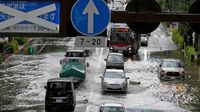On Thursday, September 11, 2025, Tokyo experienced one of its most disruptive rainstorms in recent memory, as a sudden and intense deluge swept across the capital, flooding streets and paralyzing key transport systems. According to the Japan Meteorological Agency, a staggering twelve centimeters (4.7 inches) of rain fell in just one hour, overwhelming drainage systems and leaving thousands scrambling to adjust their evening plans.
The effects were felt almost immediately across the sprawling metropolis. Social media platforms lit up with images and videos of waterlogged intersections and submerged sidewalks, with some users even reporting hail during the peak of the storm. The rain was so intense that major arteries in the city ground to a halt, as drivers and pedestrians alike struggled to navigate the sudden onslaught. For many, the day’s routine was upended in a matter of minutes.
Perhaps the most significant disruption came at Tokyo’s Haneda Airport, one of the world’s busiest aviation hubs. Air traffic control and other ground services were forced to halt operations due to lightning, effectively preventing aircraft from taking off. As reported by the Associated Press and confirmed by airport officials, this abrupt suspension left passengers stranded and flights delayed, with ripple effects likely to be felt throughout the region for hours to come. An official airport statement urged travelers to stay informed, stating, “Due to adverse weather conditions, some flights to and from Haneda Airport may be subject to delays or other disruptions. For further details, please kindly check with your airline.”
The disruption was not limited to the skies. Railways, including the iconic bullet train and several other regional lines, were also temporarily suspended. According to coverage from the Japan Meteorological Agency and corroborated by multiple outlets, these suspensions underscored just how unprepared even the most advanced urban infrastructure can be when faced with truly extreme weather. Commuters found themselves stranded at stations, waiting anxiously for updates as authorities worked to assess the situation and restore services.
Power outages added another layer of difficulty for residents. The Tokyo Electric Power Company Holdings reported that more than 7,000 homes lost electricity at the height of the storm. While most had their supply restored by late Thursday, the brief blackout served as a stark reminder of the vulnerabilities that remain in even the most technologically advanced cities. For many families, the loss of power meant a scramble to secure flashlights, check on elderly neighbors, and monitor weather updates through mobile devices.
Authorities were quick to respond, issuing urgent advisories and warnings as the scale of the disruption became clear. The Japan Meteorological Agency and local officials cautioned that more thunderstorms were expected overnight and urged residents to stay indoors, avoid unnecessary travel, and keep a close eye on evolving weather updates. Their message was clear: safety first, as conditions could deteriorate further with little warning.
For Tokyoites, the evening became a study in adaptation. Many businesses closed early, and public events were canceled or postponed. Office workers who might have otherwise enjoyed a post-work dinner or drink instead found themselves seeking shelter in train stations or convenience stores, waiting for the worst to pass. Local news outlets and social media influencers worked overtime to provide real-time updates, sharing tips on safe travel routes and the latest information from city authorities.
While the city is no stranger to heavy rainfall—Japan’s rainy season is infamous for its sudden downpours—Thursday’s storm was notable for both its intensity and the breadth of its impact. In a city built on efficiency and precision, the abrupt halt to daily life was a jarring reminder of nature’s unpredictable power. Even the famed bullet train, a symbol of Japanese punctuality and technological prowess, was forced to yield to the elements, its sleek carriages standing idle as torrents of rain battered the tracks outside.
As the evening wore on, the focus shifted to recovery and preparation for what might come next. Emergency crews fanned out across the city, clearing drains and checking for damage. Utility workers raced to restore power to the last remaining darkened homes. Meanwhile, meteorologists continued to track the storm system, warning that the risk of further thunderstorms remained high into the night. The city’s residents, for their part, heeded the call to caution, with many choosing to stay put and ride out the weather from the safety of their homes.
The broader context for Thursday’s storm is a growing concern over extreme weather events in Japan and around the world. Scientists have warned that climate change is likely to make such deluges more frequent and more severe, a trend already visible in recent years. Urban planners and policymakers are increasingly focused on how to make cities like Tokyo more resilient, investing in upgraded drainage systems, flood barriers, and emergency preparedness campaigns. Yet, as this latest storm demonstrated, even the best-laid plans can be put to the test by a truly extraordinary event.
For those caught in the chaos, there were moments of solidarity and community spirit. Strangers shared umbrellas and offered directions to the nearest dry shelter. Volunteers helped direct traffic away from the worst-hit areas, and local businesses opened their doors to stranded commuters. In a city of more than 13 million, these small acts of kindness helped soften the blow of a difficult evening.
By late Thursday, the worst of the immediate crisis had passed, but the sense of unease lingered. With more storms forecast overnight, residents remained on high alert, checking weather apps and listening for updates from city officials. The hope, of course, was that the next round of storms would be less severe, and that life in Tokyo could quickly return to its usual rhythm.
Thursday’s deluge was a stark reminder of the challenges posed by extreme weather in an era of rapid urbanization and climate uncertainty. For Tokyo, it was a night of disruption, adaptation, and resilience—a test that, for now, the city appears to have weathered, but one that is unlikely to be the last.






